Summary of Annibale Carracci
Though a rather humble and unassuming fellow, Annibale Carracci emerged as one of the most dynamic and respected painters of late sixteenth century Italy. He is acknowledged almost universally as the most important figure in the transition between the Mannerist and Baroque movements. Resisting the aesthetic enticements of the artificial and over-elaborate style of the former, Carracci promoted a return to the subtle naturalism as practiced previously by the likes of Titian, Tintoretto, Veronese and Correggio. Before making his name as an artist in his own right, Carracci collaborated closely with his brother Agostino and his cousin Ludovico. As a collective - known as "The Carracci" - the three men established an Academy in their hometown of Bologna through which they promoted drawing from live models and discussions on theoretical issues effecting art practice and history. As a collective, the Carracci undertook important public commissions together. Emboldened by a youthful socialist idealism, the three men refused to take individual credit for their work: "It is by the Carracci: all of us did it" proclaimed Annibale on completion of their best known commission for the Palazzo Fava. In pioneering a style that bled elements of naturalism and classicism with real figures and vivid Venetian coloring, the Carracci helped launch Bologna as a centre for 17th century Baroque painting.
Accomplishments
- Though justly considered a founding father of the refined Baroque style, Carracci's oeuvre includes more rugged, humanist, works that reflect his own humble Bolognese beginnings. In paintings such as The Butcher's Shop and The Beaneater, he used broken brushwork to bring an artisanal authenticity to paintings celebrating the ordinary lives of local workers and shopkeepers.
- Carracci has been credited with allowing painting to rank alongside sculpture in its ability to represent an intense, full-bodied, figurativism. In works such as his Pietà (c.1600), he blended the understated realism, for which he was already well known, with dynamic chiaroscuro tones that infused his corporeal religious figures with a spiritual three-dimensional presence.
- Carracci synchronized all his influences on his most famous frescoes, including those for the Palazzo Farnese in Rome. Here we see him bring subtle chiaroscuro shading to naturalistic flesh tones in order to distinguish individual characters within his expansive narratives. His characters are then placed in settings that are of equal measure in the finery of their detail. It was his ability to create such complete compositions that finally brought him deserved universal recognition.
Important Art by Annibale Carracci
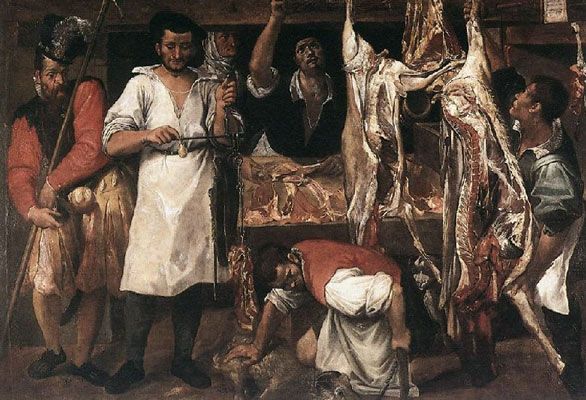
The Butcher's Shop
Classified as a genre painting, The Butcher's Shop, in which Carracci depicts butchers preparing their wares for sale, holds up a window to everyday Italian life during the late 1500s. The butcher in the center foreground is shown preparing a lamb for slaughter, while his assistants are seen hooking up carcasses for display. Bringing a dash of humor to the scenario, a customer wearing an oversized feather hat in the left corner is seen fumbling for money to make his purchase. Based on the known fact that Carracci's uncle worked as a butcher, historians have speculated that Carracci may have represented his own family members in this painting.
In late-sixteenth century Bologna, artisans and shopkeepers occupied the bottom rungs of the social ladder. This group lived under the constant threat of job loss due to economic instability and a weakened guild system. Since the milieu in which he was painting reflected his own humble beginnings, one finds in this image clear evidence of Carracci's commitment to "painting from real life". This is apparent too in his preference for broken brushwork which brings added authenticity to the humanistic element of the work (shown thematically in the way the butchers are represented as humble masters of their trade). At the same time, Carracci shows a light-hearted touch through the inclusion of the humorous caricature of the paying customer.
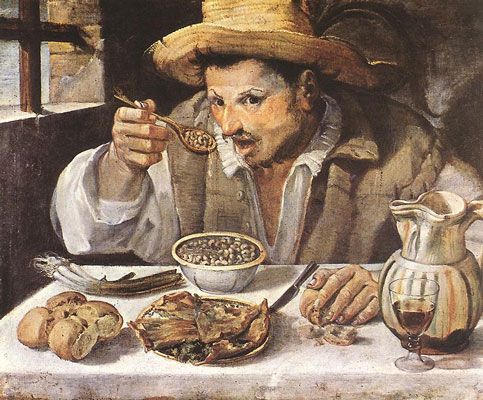
The Beaneater
Like the Butcher's Shop, The Beaneater is a naturalistic genre painting representing a scene of everyday Italian life. It shows a man eating a simple meal of beans, onions, bread and wine. In order to infuses the painting with an authentic rustic feel, Carracci used broken brush work; a technique that went against the flat polished finish that fine artists strived for during the late 16th century.
Carracci's composition combines portraiture and still life and offers thus a clear example of his ability to bring together different components in a single painting. Depicted in a manner that appears candid, this approach would have been seen as markedly different during a time when painting was drawn towards monumental depictions of biblical figures and posed portraits of prominent society members. The lack of composure and level perspective creates a similar compositional result that is akin to a photograph taken from the opposite side of the table. The beaneater is captured in a spontaneous moment evident in his direct engagement, blushed cheeks, and gaping mouth. Despite this somewhat unflattering portrayal, the level perspective does not belittle the subject but, rather, places the spectator at social plateau with the sitter. Carracci captures a simple daily routine of the working class with sympathy, representing the man in a manner that is ultimately human; a strategy which would have been deemed innovative during the 16th century when wealthy commissions dominated portraiture.
Oil on canvas - Palazzo Colonna, Rome
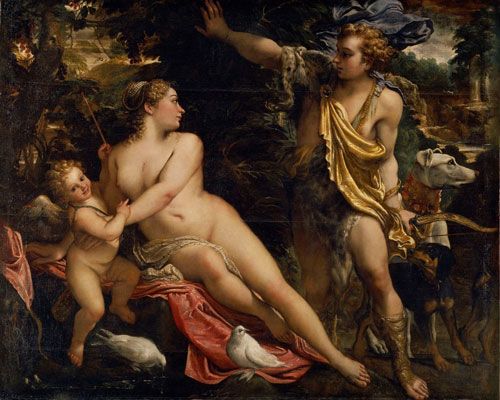
Venus, Adonis and Cupid
Venus, Adonis and Cupid focusses on a story associated most famously with the Roman poet Ovid. In this painting, Carracci depicts the moment before Venus is about to be struck by Cupid's arrow allowing her to fall in love with Adonis (who is shown with hounds that will accompany him when he proceeds to embark on an ill-fated hunt with a wild boar). In the foreground we see a pair of doves that represent love. The figures are backed by an intricate landscape comprising of ancient ruins and chaotic skies, infusing a sense of drama into the narrative.
Venus, Adonis, and Cupid is demonstrable of the wide range of influences that Carracci undertook, exhibiting aspects of Veronese, Titian and Greco-Roman sculptures. Both Veronese and Titian painted this fable, and similarities can be drawn between the compositional approach of all three artists in which the interaction between Venus and Adonis is played out in front of a naturalistic landscape. Carracci's special skill as a naturalist painter is in evidence here while his sculptural formation of the figure's bodies, and the use of light to illuminate the smooth texture of their skin produces a subtle realism that would have placed it in stark contrast to the preferences of the Mannerists. Carracci's ability to play with light in this way is further evidenced in the cloth materials, most notably in the wonderful iridescent sheen of Adonis's robe.
Oil on canvas - Museo del Prado, Madrid
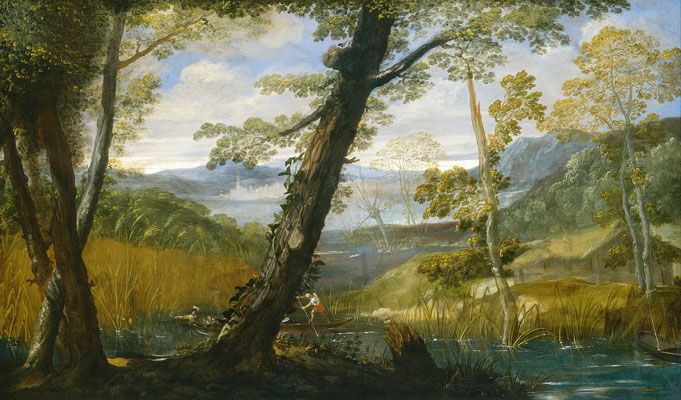
River Landscape
With his brother Agostino, and cousin Lodovico, Annibale undertook several excursions into the Bolognese countryside to sketch. From these sketches, Carracci would make up his splendid landscape paintings in his studio. With its emphasis on contrasts in color, its fine attention to detail, and its sense of grandeur and movement, paintings like River Landscape effectively "invented" the landscape as a legitimate genre for Italian Baroque painting.
Here, Carracci produces a fine balancing of forms throughout his canvas. A river wends its way among fields in its journey from the middle distance towards the foreground. Trees and foliage act almost as signposts for the river's rhythmic passage; its rippled waters dappled with reflections of sunlight. The huge dark tree trunks that dominate the near foreground, meanwhile, effectively stop the spectator from becoming lost in the pastel skies and mountainous range of the far horizon. We see too a human presence in the shape of the boating party, with the boatman himself distinguished from his surroundings through his brightly colored red and white clothing. On the rivers horizon we also see other man-made marks in the shapes of what look like buildings. As the founding father of the Baroque movement Carracci's River Landscape can be viewed as a harbinger of things to come, anticipating the soft landscapes of Jean-Honore Fragonard and Anthony Van Dyck.
Oil on canvas - The National Gallery of Art, Washington DC
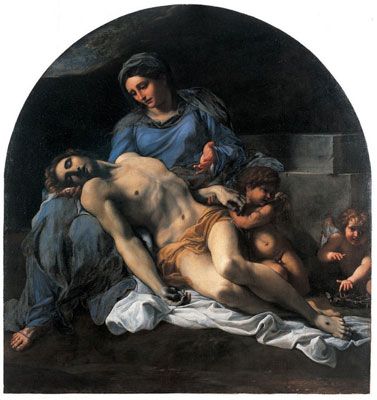
Pietà
One of his later works, Carracci was working on Pietà whilst undertaking his project at the Farnese Gallery in Rome, both of which were commissioned by Cardinal Farnese, a wealthy and powerful patron of the arts who had an eye for rising talent. In Pietà, Carracci presents the moment in which the Virgin Mary holds her crucified son, who lay lifeless on her lap. To the right of the composition, angels are depicted in the act of mourning Christ's passing.
The artist's rendering of the subjects is an obvious nod to Michelangelo's sculpture Pietà (c. 1498-9) in which similarities can be drawn between the triangular composition resulting from the elevation created by the steps and the sculpted quality of the depicted figures. In combination with these elements, Carracci furthers the realist treatment of the drama by applying a number of other techniques. For instance, chiaroscuro tones are present within the painting, illuminating Christ's body and emphasizing his holiness. A shadow casts itself over the Virgin Mary's face, extenuating the sorrow in her expression. An angel gestures to Christ's wounded feet to suggest the sacrifice that he has endured. Overall, Pietà can be considered a demonstration of Carracci's adeptness at transferring the monumentality of sculpture into painting, and infusing the imagery with a palpable figurative dynamism that was thought hitherto to be the sole privilege of sculpture.
Oil on canvas - National Museum of Capodimonte, Naples
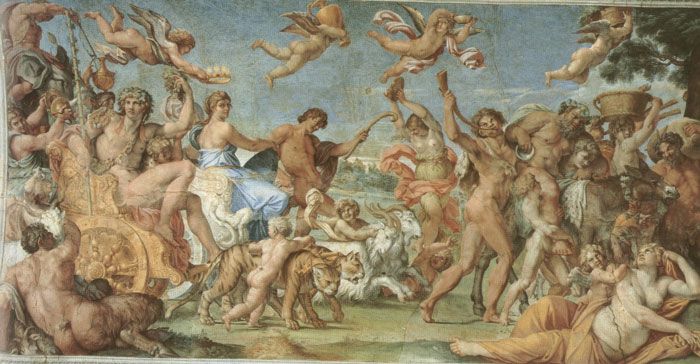
The Triumph of Bacchus and Ariadne
In 1597, Carracci was commissioned by Cardinal Odoardo Farnese (Pope Paul III's nephew) to decorate the gallery on the main floor of his Roman palace, considered one of the most important examples in Renaissance architecture (it currently houses the French embassy in Italy). The result was, by almost universal consensus, an achievement to rank alongside the greatest of all monumental fresco paintings, namely Michelangelo's Sistine Chapel and the equally famous Rafael Rooms. Carracci's work represented a complete break with Mannerism and introduced the Baroque style which would dominate during the seventeenth century.
Displayed as the centrepiece for the vault fresco cycle, Loves of the Gods, The Triumph of Bacchus and Ariadne focusses on the wedding ceremony of Bacchus and Ariadne, in which the couple are seen riding on a chariot that is drawn by tigers and goats. Ariadne is crowned with stars from cupid as they are cheered on by the crowd, evoking a celebratory atmosphere. Silenus is seen to the right of the composition, riding a donkey into the distance. What is extraordinary about the frescoes is the fact that, unlike Michelangelo's Genesis and Last Judgement frescoes, or Raphael's frescoes for the Vatican apartments, which were all religious, Carracci's frescoes were - unlike the crucifixion scenario of Pietà - mythological, a highly unexpected choice of subject matter given that Rome was at the very center of the Catholic Counter Reformation.
Its thematic emphasis aside, the fresco shows Carracci's ability to convey a diverse range of emotions and personalities. Despite the many individual figures, each one carries their own unique expression. Bacchus holds a cluster of grapes in a heroic fashion that accentuates his muscular physique, gazing off gallantly into the distance. Ariadne looks over her shoulder, expressing a passiveness that contrasts with Bacchus. A drunken Silenus is seen lending all of his weight onto another figure, who appears to almost suffocate from his overbearing grasp. Carracci's rendering of the flesh is so noteworthy for every shadow that forms and each muscle that is captured (suggestive of an artist such as Rubens).
Fresco - Palazzo Farnese, Rome
Biography of Annibale Carracci
Childhood
Brothers Annibale and Agostino Carracci was raised in Bologna in an area now known as Via Augusto Righi. Like Caravaggio's Milan, Carracci's Bologna, a papal state since 1506, was in the midst of an intense religious and scientific upheaval. By the end of the century, the city had undergone significant reconstruction; emerging as a center of academic and scientific learning. However, the Bologna region was also in the grips of an economic crisis brought on by plague and famine and the city streets in which Annibale grew up became home to hordes of peasants.
Annibale did not come from an artistic background. His father, Antonio, was a humble tailor, and his uncle, Vincenzo, worked as a butcher. Due to limited funds, Annibale was only able to attend school until the age of 11. Yet despite his limited schooling (or, perhaps, because of it) it has been suggested by several historians that Annibale was a natural draftsman, with various anecdotes confirming his innate talent. The most well-known of these was told by Carracci's biographer, Bellori, who recounted a tale from the artist's early childhood. The story goes that one day Annibale was accompanying his father to Cremona where he (his father) was to sell off a small plot of land. On their journey back to Bologna, a group of peasants accosted and robbed Antonio. Having arrived at the police station to report the crime, little Annibale drew a portrait of the robbers with such speed and accuracy the police were able to immediately apprehend the criminals and return Antonio's money.
Early Training and Work
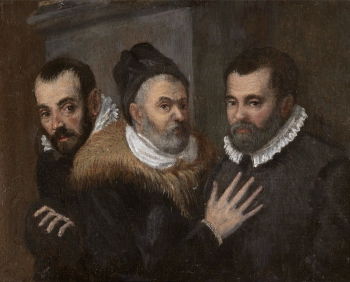
Annibale started his working career as an apprentice goldsmith. In Bellori'a account, part of his training involved learning to draw which he did with his cousin, Ludovico Carracci. Annibale's talent was formally recognized leading to him to being (re)apprenticed to the successful local artist, and prominent Mannerist, Bartolomeo Passerotti. Indeed, in the 1570s, painting in Italy was dominated by a Mannerist tendency that exaggerated the proportions of figural depictions to create elegant imagery conjured from the artists' own imaginations. It is likely, however, that Annibale's formative years exposed him to other influences, including his immediate surroundings. It is evident that Carracci followed in the style of Passarotti, but his individualistic approach indicates that he would have been self-taught given that it remains unlikely (not to mention undocumented) that he could have served under a second Master.

Annibale, like Agostino, started his professional career as an engraver, working on large prints from about the age of 21. It is thought that his first altarpiece painting, the Crucifixion (1583), was produced two years later. His figures, which were construed according to natural, rather than elongated, human proportions, suggests that Carracci was already showing his independent spirit by rebelling against the Mannerist style. Indeed, Crucifixion was not at all well received. Deemed naïve, Crucifixion meant it was initially difficult for Carracci to establish himself as a serious artist.
Undeterred by the criticism, Carracci travelled throughout Italy where he absorbed a variety of influences including Raphael and Pellegrino Tibaldi. Initially, however, it was Antonio da Correggio who exercised most influential over Carracci. Correggio had such an influence on Annibale in fact that in a letter dated in 1580, he stated that he was financing a trip to Parma by creating and selling copies of Correggio's work. Carracci studied Correggio so closely it often proved difficult to discern which artist had painted what work.
In the same year as his trip to Parma, Annibale travelled on to Venice where he was reunited with his brother. Agostino had been in Venice for some time having trained under the renowned Dutch engraver and draughtsman Cornelis Cort. From 1574, he worked as a reproductive engraver charged with copying works of 16th century masters including Veronese, Federico Barocci, Antonio Campi, and Correggio. He also produced a small number of original etchings of some renown. Once reunited, however, the brothers would study the works of Titian, Giorgione and Tintoretto from whom they learned of the Venetians' mastery of color and light. Annibale's opinions of other artists were made evident in annotations he left in a copy of Giorgio Vasari's Lives of the Artists (1550); a tome he was apt to criticize for the author's unabashed preference for Florentine artists. In his annotations Annibale emphasised that Titian was divine and that Venetian art was instrumental in his artistic formation. Bolognese art was also significant to Annibale who visited Jacopo Bassano's studio during his early years, remarking favourably on his ability to create striking illusion within his compositions.
Having resettled in Bologna, a city now in the grips of a religious reformation, Annibale, Agostino and Ludovico, established their Academy in 1582. It is not known how the Academy fared initially, but by the late 1580s it had become a teaching institution known as the Accademia dei Desiderosi ("desirous of fame"). All three men were opposed to what they saw as the obscure and false fantasies of Mannerism and used the Academy to promote the idea that art should draw directly on nature for its influences. The Carracci taught life study, proportion, anatomy, perspective and architecture and young Bolognaise artists rushed to study there.
The city's art establishment was however enraged at the audacity of three young upstarts who saw fit to open an academy long before they had established themselves individually. As a collective, however, the Carracci had been given their first opportunity to collaborate on a commission for the Palazzo Fava in 1583. The frescoes, which depicted the stories of Jason and Ludovico, were thought to have been directed by Agostino as he was at that time the most established of the family. Indeed, Annibale, cast in the shadow of his brother and cousin, was struggling to secure religious commissions independently of the family.
It was outside Bologna that Annibale was finally able to obtain religious patronage, fulfilling commissions in Parma, Reggio nell' Emilia, and completing altarpieces for the church of San Prospero. Indeed, Carracci's "anti-mannerist" style sat well with the campaign of the Catholic Counter Reformation Act and his religious commissions led in fact to his religious treatments being in very high demand.
Mature Period
Over the years, the Carracci Academy established itself within the arts circle and was attended by many students, including painters such as Guido Reni and Domenichino. Students and contemporaries of the Academy began to adopt a more naturalistic style. In 1589, the name of the Academy was changed, probably at the request of Agostino, to Academia degli Incamminati ("Academy of the Progressives") to emphasize the intellectual aspect of the school. As part of the curriculum, emphasis was placed on the practice of drawing with Annibale stressing the importance of taking from real life. The idea of creative "Invenzione" (invention) has often been associated with the Carracci and as an indicator of its progressive practice, that were credited with the invention of the caricature and proponents of pictorial riddles.
Other creative practices within the Academy involved attempting to finish a drawing without lifting the pen from the paper in an attempt to produce the most fluid composition. Although the Carracci took the education of art seriously, it has been argued that they still had time to prank their fellow students. A stunt involving the brothers scaring Pietro Faccini by secretly moving the skeleton that he was studying has been cited as exemplary of their love of practical jokes. However, it has been suggested by art historian Clare Robertson that working at the Academy may have exacerbated differences between Annibale's and Agostino's practice. Annibale is thought to have become so bored with Agostino's theoretical ramblings that he once jibed "those of us who are painters have to do talking with our hands".
The Carracci were given a further opportunity to fulfil a collaborative project when they worked on a commission for the main salone at Palazzo Magnani. The Carracci's style was so consistent that many observers wondered which artist was responsible for which paintings. Annibale responded in fact by saying "It is the Carracci: we all of us did it". Between 1591-2, the trio worked on Palazzo Sampieri, which turned out to be their last collaborative project. They had by now achieved enough success as a family that they started to explore their art individually, emerging in fact as rivals. This became evident through their artistic influences, when in 1592 Ludovico spoke of favouring Tintoretto while Annibale and Agostino's preference was for Titian and Veronese. It is thought that the artistic division between the Carracci became so pronounced that their rivalry started to show within the workshop, with one group following the teachings of Ludovico and another following Annibale and Agostino.
By 1594 Carracci had garnered a considerable personal reputation and he caught the attention of one Cardinal Farnese, a wealthy and influential patron of the arts who wanted a new talent to execute frescoes for his Palazzo Farnese in Rome. But Annibale's new project merely triggered further tensions within the Carracci. Ludovico was happy at the Academy in Bologna and did not want to move to an area where he would have to re-establish himself. Agostino did join his brother in Rome three years later (in 1597) but the time delay suggests that there was a growing distance between them. The brothers did collaborate on a small number of cycles but they argued frequently, with Annibale lambasting his brother for his "intolerable pretentiousness".
Late Period
Cardinal Farnese engaged Carracci on a contract of meals and lodgings and a stipend of 10 scudi per month. The artist worked on the Farnese frescoes for six years, producing works that would represent the very summit of his oeuvre and a landmark in the history of Italian art.
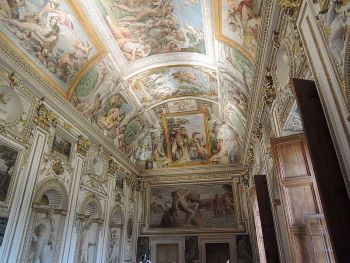
The Palazzo Farnese frescoes were a monumental personal achievement for Carracci, not least because he remained all-but cut-off from the outside art world for some six years. It was a truly difficult time for Carracci given that the Cardinal treated him with little respect and publicly ridiculing him for his untidy clothes and unassuming manner. Carracci was further burdened with menial responsibilities (for an artist of his undeniable talents) such as designing dishes and silverware and even making decorative panels to be sewn onto the Cardinal's clothes.
The finished frescoes were lauded all over Rome when they were revealed in 1601. But the Cardinal delivered a crushing humiliation on Carracci when he calculated the cost of the artist's total food intake and subtracted it from his fee, leaving him with the meagre sum of 500 scudi. A crestfallen Carracci took the payment without complaint but the artist succumbed to a deep depression vowing never to paint again. Shortly after the Farnese debacle, Carracci suffered a stroke which robbed him temporarily of speech. He suffering was compounded the following year by the death of Agostino, and the death of his mother soon thereafter. He did manage to execute a few more works, most with the help of apprentices, before he succumbed to a fatal fever.
Carracci died in 1609 with the words: "This time, my dear doctor, the workings of the clock are broken, you need not concern yourself with them further, they are beyond repair". Carracci was buried with the great of pomp and ceremony, achieving at last the recognition he never fully received in his lifetime. His body was placed on a catafalque and mourned by the Academy of Saint Luke (the painter's association in Rome) and buried, in accordance with the artist's wishes, next to his idol Raphael.
The Legacy of Annibale Carracci
Carracci is hailed as one of the founding fathers of what would become recognized as the Baroque period, and, though his career was relatively short (he died aged just 49), he left a legacy of bold experimentation that effectively dethroned Mannerism as the elite artistic practice.
Like other legendary artists, Carracci possessed the will and imagination to resist the prevailing stylistic tendencies. Though a meek and introverted figure, he fought hard against the extravagances of Mannerism but without succumbing to the raw realism of Caravaggio. His emphasis on the importance of drawing from life, in combination with the application of an air of classicism and naturalistic backgrounds, invigorated pupils who acted as a prominent link within the evolution of Italian art. Indeed, the city of Bologna became home to the so-called Bolognese School which overtook the Parma School of painting and, through the efforts of pupils such as Francesco Albani, Domenico Zampieri, Giovanni Lanfranco, Guercino and Guido Reni, spread the influence of Baroque painting throughout Italy via Florence, Rome, and Naples.
The Baroque period infused art with new values that informed the oeuvres of future generations of painters too. Indeed, the Baroque style was carried forward by such luminaries as Nicolas Poussin and Peter Paul Rubens, whose illuminated rendering of the flesh and delicate naturalist backgrounds, fully merit their comparisons to Carracci.
Influences and Connections

- Ludovico Carracci
- Agostino Carracci
- Bartolomeo Passarotti
- Guido Reni
- Domenichino
- Sisto Badalocchio
- Giovanni Antonio Solari
Useful Resources on Annibale Carracci
- The invention of Annibale CarracciOur PickBy Clare Robertson
- Annibale Carracci and the beginnings of the baroque styleBy Charles Dempsey
- Annibale Carracci: The Farnese Gallery, RomeBy Charles Dempsey
- Annibale Carracci's Venus, Adonis and CupidBy Andres Ubeda de los Cobos , Ana Gonzalez Mozo, Maria Alvarez Garcillan
- Annibale Carracci: Study in the Reform of Italian Painting Around 1590Our PickBy Donald Posner
- Malvasia's Life of the Carracci: Commentary and TranslationBy Anne Summerscale
 Ask The Art Story AI
Ask The Art Story AI
















